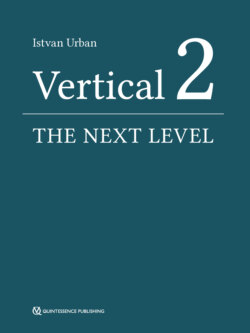Оглавление
Istvan Urban. Vertical 2: The Next Level of Hard and Soft Tissue Augmentation
Vertical 2
Preface
Acknowledgments
Contents
Introduction. 1. The biology of vertically and horizontally augmented bone
The histology of polytetrafluoroethylene (PTFE) membranes in an in vivo setting
Bone growth using a xenogenic bone graft
Dense versus perforated membrane
I. Dense vs perforated membrane using bone morphogenetic protein-2 (BMP-2) as a graft
II. Perforated vs non-perforated membranes using an osteoconductive graft material
III. The effect of the use of a microdose of BMP-2 in combination with an osteoconductive xenograft
Conclusion
Reference
Additional reading
2. Scientific evidence of vertical bone augmentation utilizing a titanium-reinforced polytetrafluoroethylene mesh. Introduction
Materials and methods
Inclusion and exclusion criteria
Surgical procedure
Postsurgical procedures
Data collection
Statistical analysis
Results. Patient characteristics
Bone gain analysis
Influence of baseline vertical deficiency on absolute and relative bone gain
Influence of defect location on absolute bone gain: maxilla vs mandible
Influence of defect location on absolute bone gain: anterior vs posterior
Influence of defect location on absolute and relative bone gain: anterior vs left posterior vs right posterior
Postsurgical complications
Discussion
Agreement with previous studies
Distinctive findings
Limitations and recommendations for future research
Conclusions
Representative case examples of ridge augmentation using a perforated d-PTFE membrane
References
Additional reading
The extreme vertical defect of the posterior mandible. 3. Reconstruction of the extreme posterior mandibular defect: surgical principles and anatomical considerations
Introduction
References
Additional reading
4. Reconstruction of an advanced posterior mandibular defect with scarred tissue
The ‘pawn sacrifice’
Biologic healing potential of this defect
Type III buccal tissue: completely scarred periosteum
5. Reconstruction of an advanced posterior mandibular defect with narrow basal bone
Reference
6. Reconstruction of an advanced posterior mandibular defect with incomplete periodontal bone levels: the ‘pawn sacrifice’
Reference
7. Reconstruction of an advanced posterior mandibular defect with the Lasagna technique using low-dose bone morphogenetic protein-2
Anterior mandibular vertical augmentation. 8. Reconstruction of the advanced anterior mandibular defect: surgical principles and anatomical considerations
Reference
Additional reading
9. Reconstruction of the advanced anterior mandibular defect: considerations for soft tissue reconstruction and preservation of the regenerated bone
Lingual soft tissue grafting
Lessons learned
10. Reconstruction of the advanced anterior mandibular defect: importance of horizontal bone gain
Posterior maxilla. 11. Long-term results of implants placed in augmented sinuses with minimal and moderate remaining alveolar bone
Sinus grafting using the sagittal Sandwich technique
Clinical characteristics and demographic profiles
Implant placement
Healing of the sinus grafts
Marginal bone loss
Comparison between Mk III and Mk IV
Survival rate
Peri-implantitis
References
Additional reading
12. Difficulties and complications relating to sinus grafting: hemorrhage and sinus septa
Hemorrhage
Sinus septa
Classification of sinus septa
References
Additional reading
13. Difficulties in sinus augmentation and posterior maxillary reconstructions: missing labial sinus wall and ridge deficiencies. Missing buccal bony wall: the Island technique
Combination of missing buccal and nasal bone in addition to a ridge defect
Crestally missing bone: the Atomic Bomb design
14. Sinus graft infection and postoperative sinusitis
Diagnosis of sinus graft infection
Surgical intervention to treat graft infection
Systemic pharmacologic treatment of infection
Sinus graft infection with concomitant sinusitis
Representative case of sinus graft infection with concomitant sinusitis and ‘purulent backflow’
Untreated sinus graft infection
References
Additional reading
15. The reconstruction of an extreme vertical defect in the posterior maxilla
Long-term follow-up after an extreme posterior maxillary vertical ridge augmentation
Reference
Additional reading
Anterior maxillary vertical augmentation. 16. Introduction and clinical treatment guidelines. Introduction to the anterior maxilla
Clinical guidelines: surgical treatment of an advanced anterior maxillary vertical defect
Representative case of an advanced vertical and horizontal deficiency
Additional reading
17. Complex reconstruction of an anterior maxillary vertical defect
Anterior maxillary defect. 18. Extreme defect augmentation in the anterior maxilla
Soft tissue reconstruction in conjunction with bone grafting. 19. Reconstruction of a natural soft tissue architecture after bone regeneration. Introduction. Goals and strategies
Treatment strategy. 1. Hard tissue grafting
2. Soft tissue grafting
Treatment schemes for soft tissue reconstruction of mucogingival distortion
Representative case of a free connective tissue graft placed around natural teeth
Treatment scheme for soft tissue reconstruction
References
Additional reading
20. The labial strip gingival graft. Labial strip gingival graft for the esthetic reconstruction of mucogingival distortion
Surgical intervention
Study outcomes
Data analysis
Results
Bone regeneration, reconstruction of the interdental papilla, and a labial strip graft in combination with a collagen matrix
Labial strip gingival graft in combination with an open healing connective tissue graft and a collagen matrix
Discussion
Conclusions
References
21. The double strip graft
The double strip technique
22. Large open-healing connective tissue graft
Reconstruction of the interimplant papilla. 23. The double connective tissue graft
24. The Ice-cube connective tissue graft
Additional reading
25. The Iceberg connective tissue graft
Case 1
Case 2
Case 3
Interproximal bone and soft tissue regeneration. 26. Vertical periodontal regeneration in combination with ridge augmentation
Additional reading
Ultimate esthetics. 27. Reconstruction of the bone and soft tissue in conjunction with preserving the mucogingival junction. Avoiding mucogingival distortion after ridge augmentation
28. Complications
Case 1
Case 2
Postoperative infection
Case 3
Case 4
Some of the author’s personal experiences with other types of exposures. Exposure of a titanium mesh
Case 5
Case 6
Conclusion
Reference
